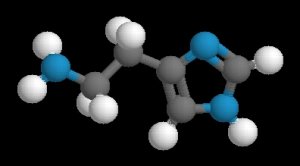

MedFriendly®


Biogenic Amines
A biogenic amine is a biogenic substance (a substance
produced by life processes) with one or more amine
groups. An amine is a chemical substance in which one
or more hydrogen atoms in ammonia (a type of
colorless gas with a strong smell) are replaced by a
functional group. A functional group is a group of atoms
responsible for the specific reactions of a certain
compound. An atom is the smallest part of a substance
that can exist and still possess all of the properties that
are characteristic of the substance. Hydrogen is the
most common non-metallic element in the universe.
The chemical structure of
histamine, a type of biogenic
amine.
FEATURED BOOK: Biogenic Amine Receptors
Some amines are known as endogenous, meaning that they are produced inside the
body (since endo- refers to the inside). These amines are specifically produced in
different types of tissues such as the brain or the liver and distributed locally or
elsewhere via the blood. The liver is the largest organ in the body and is responsible for
filtering harmful chemical substances, producing important chemicals for the body, and
other important functions.
Some amines are known as exogenous, meaning that they are produced outside the
body (since exo- refers to the outside) and absorbed directly by the intestine. The rate of
absorption of these amines can be increased with alcohol consumption.
"Where Medical Information is Easy to Understand"™
To prevent too much reabsorption of the biogenic amines, they are
broken by an enzyme known as monoamine oxidase (MAO). An
enzyme is a type of protein that helps produce chemical reactions in
the body. There are medications known as MAO Inhibitors which
can inhibit the action of MAO, making more amines available for use
such as amines that maintain a positive mood. This is why MAO
Inhibitors are sometimes used to treat depression but special care
must be taken because the increased availability of amines can
cause dangerous side effects such as very high blood pressure if
certain foods containing high levels are ingested such as cheese
and pork.
There are many different types of biogenic amines. One of the most well-known is histamine, which plays
a key role in allergic reactions. This is why some medications used to treat allergies are known as anti-
histamines. Another type of amine is serotonin. Serotonin is a chemical messenger produced in the
intestine (mostly) and the brain that contributes to feelings of well-being, happiness, exerts a calming
effect, and regulates appetite, sleep, and sexuality.
Some other well-known biogenic amines are epinephrine (also known as adrenaline), norepinephrine, and
dopamine, collectively referred to as catecholamines due to their similar chemical makeup. Norepinephrine
is a type of chemical messenger that helps to increase blood pressure and also regulates sleep,
alertness, appetite, and attention. Dopamine is a chemical messenger in the brain that is important for
slowing down and coordinating movements, motivation, and causing pleasurable sensations.
Some amines are referred to as trace amines because they are found in trace (very small) amounts in the
body, including tyramine, tryptamine, and 3-Iodothyronamine. Tyramine is found in many foods (e.g.,
meats and cheeses) and can cause increased blood pressure and cause headaches. Tryptamine is found
in the brain and helps release and enhance serotonin (see above). 3-Iodothyronamine is a byproduct of
thyroid hormones. The thyroid gland is a butterfly-shaped organ located in front of the neck that produces
hormones (natural chemicals) that affect virtually every cell in the body and many functions such as
disease fighting, heart rate, energy level, and skin condition.
Aminergic means to be activated by, characteristic of, or secreting (forming and giving off) one of the
biogenic amines. Aminergic also means relating to nerve cells or fibers. Biogenic comes from the Greek
word "bios" meaning "life" and the Greek word "genesis" meaning "production." Amine is a derivative of the
word ammonia. Put the words together and you have “life production ammonia.”















